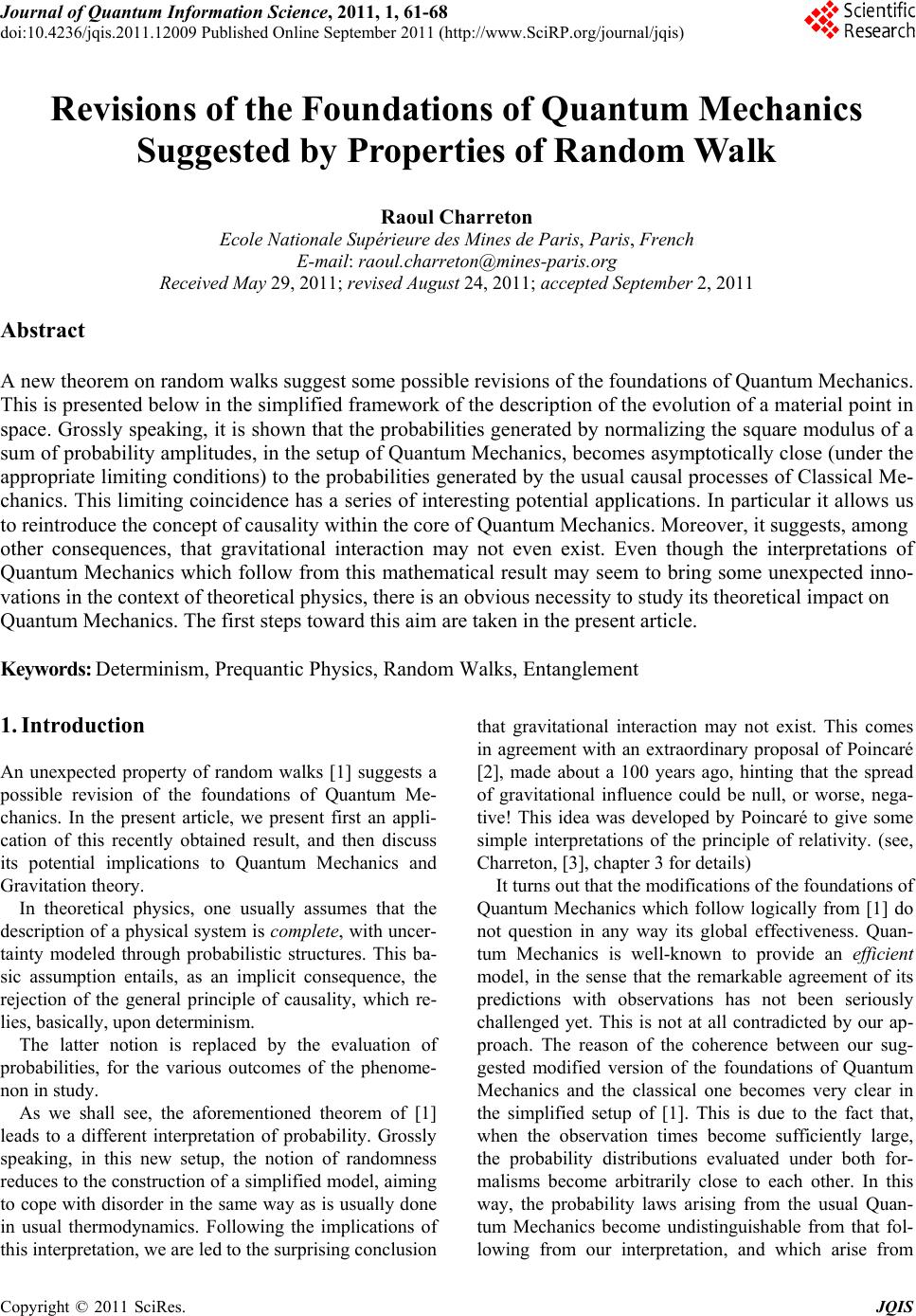 Journal of Quantum Informatio n Science, 2011, 1, 61-68 doi:10.4236/jqis.2011.12009 Published Online September 2011 (http://www.SciRP.org/journal/jqis) Copyright © 2011 SciRes. JQIS Revisions of the Foundations of Quantum Mechanics Suggested by Properties of Random Walk Raoul Charreton Ecole Nationale Supérieure des Mines de Paris, Paris, French E-mail: raoul.charreton@mines-paris.org Received May 29, 2011; revised August 24, 2011; accepted September 2, 2011 Abstract A new theorem on random walks suggest some possible revisions of the foundations of Quantum Mechanics. This is presented below in the simplified framework of the description of the evolution of a material point in space. Grossly speaking, it is shown that the probabilities generated by normalizing the square modulus of a sum of probability amplitudes, in the setup of Quantum Mechanics, becomes asymptotically close (under the appropriate limiting conditions) to the probabilities generated by the usual causal processes of Classical Me- chanics. This limiting coincidence has a series of interesting potential applications. In particular it allows us to reintroduce the concept of causality within the core of Quantum Mechanics. Moreover, it suggests, among other consequences, that gravitational interaction may not even exist. Even though the interpretations of Quantum Mechanics which follow from this mathematical result may seem to bring some unexpected inno- vations in the context of theoretical physics, there is an obvious necessity to study its theoretical impact on Quantum Mechanics. The first steps toward this aim are taken in the present article. Keywords: Determinism, Prequantic Physics, Random Walks, Entanglement 1. Introduction An unexpected property of random walks [1] suggests a possible revision of the foundations of Quantum Me- chanics. In the present article, we present first an appli- cation of this recently obtained result, and then discuss its potential implications to Quantum Mechanics and Gravitation theory. In theoretical physics, one usually assumes that the description of a physical system is complete, with uncer- tainty modeled through probabilistic structures. This ba- sic assumption entails, as an implicit consequence, the rejection of the general principle of causality, which re- lies, basically, upon determinism. The latter notion is replaced by the evaluation of probabilities, for the various outcomes of the phenome- non in study. As we shall see, the aforementioned theorem of [1] leads to a different interpretation of probability. Grossly speaking, in this new setup, the notion of randomness reduces to the construction of a simplified model, aiming to cope with disorder in the same way as is usually done in usual thermodynamics. Following the implications of this interpretation, we are led to the surprising conclusion that gravitational interaction may not exist. This comes in agreement with an extraordinary proposal of Poincaré [2], made about a 100 years ago, hinting that the spread of gravitational influence could be null, or worse, nega- tive! This idea was developed by Poincaré to give some simple interpretations of the principle of relativity. (see, Charreton, [3], chapter 3 for details) It turns out that the modifications of the foundations of Quantum Mechanics which follow logically from [1] do not question in any way its global effectiveness. Quan- tum Mechanics is well-known to provide an efficient model, in the sense that the remarkable agreement of its predictions with observations has not been seriously challenged yet. This is not at all contradicted by our ap- proach. The reason of the coherence between our sug- gested modified version of the foundations of Quantum Mechanics and the classical one becomes very clear in the simplified setup of [1]. This is due to the fact that, when the observation times become sufficiently large, the probability distributions evaluated under both for- malisms become arbitrarily close to each other. In this way, the probability laws arising from the usual Quan- tum Mechanics become undistinguishable from that fol- lowing from our interpretation, and which arise from 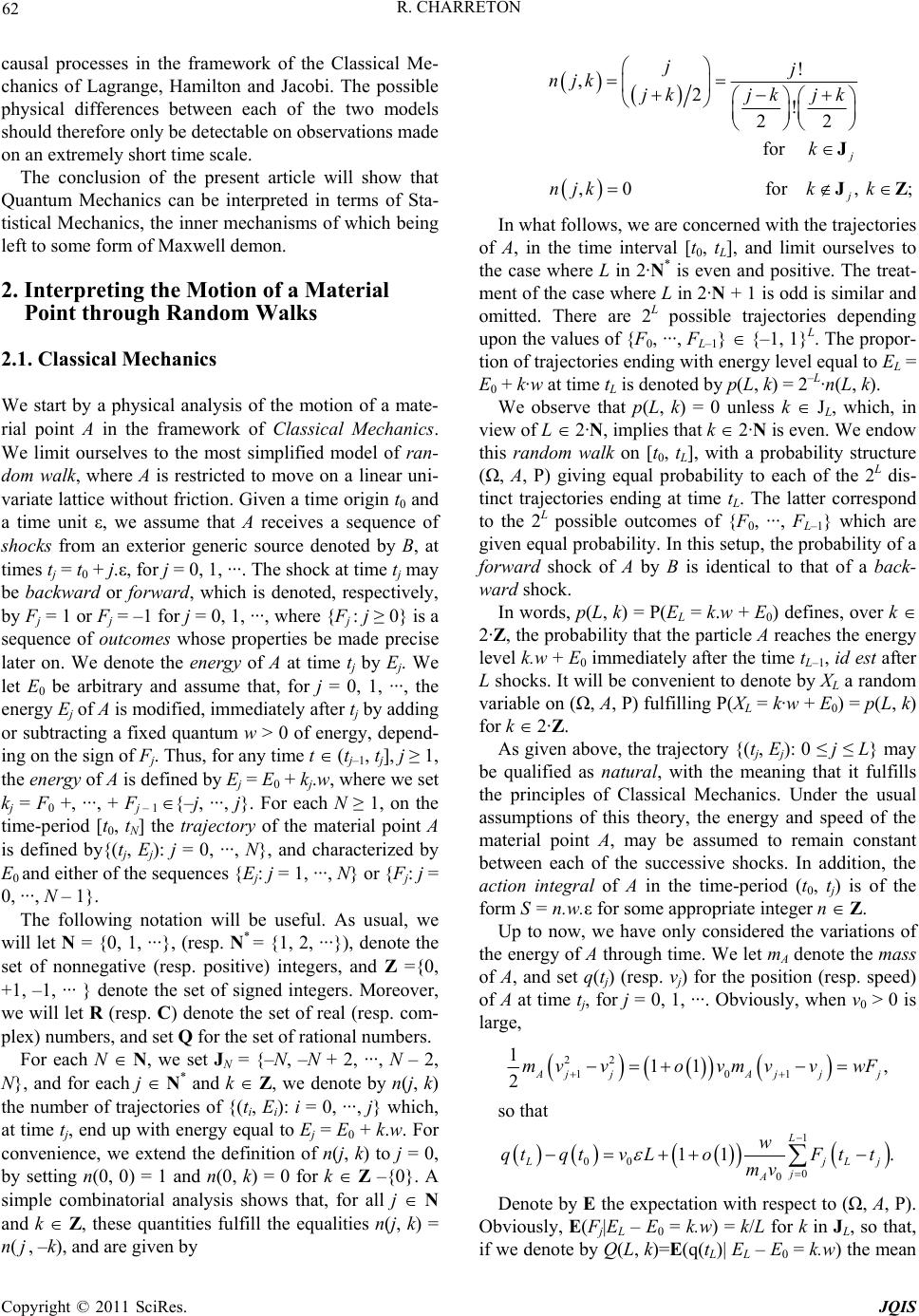 R. CHARRETON 62 causal processes in the framework of the Classical Me- chanics of Lagrange, Hamilton and Jacobi. The possible physical differences between each of the two models should therefore only be detectable on observations made on an extremely short time scale. The conclusion of the present article will show that Quantum Mechanics can be interpreted in terms of Sta- tistical Mechanics, the inner mechanisms of which being left to some form of Maxwell demon. 2. Interpreting the Motion of a Material Point through Random Walks 2.1. Classical Mechanics We start by a physical analysis of the motion of a mate- rial point A in the framework of Classical Mechanics. We limit ourselves to the most simplified model of ran- dom walk, where A is restricted to move on a linear uni- variate lattice without friction. Given a time origin t0 and a time unit ε, we assume that A receives a sequence of shocks from an exterior generic source denoted by B, at times tj = t0 + j.ε, for j = 0, 1, ···. The shock at time tj may be backward or fo rwa rd , which is denoted, respectively, by Fj = 1 or Fj = –1 for j = 0, 1, ···, where {Fj : j ≥ 0} is a sequence of outcomes whose properties be made precise later on. We denote the en erg y of A at time tj by Ej. We let E0 be arbitrary and assume that, for j = 0, 1, ···, the energy Ej of A is modified, immediately after tj by adding or subtracting a fixed quantum w > 0 of energy, depend- ing on the sign of Fj. Thus, for any time t (tj–1, tj], j ≥ 1, the energy of A is defined by Ej = E0 + kj.w, where we set kj = F0 +, ···, + Fj – 1 {–j, ···, j}. For each N ≥ 1, on the time-period [t0, tN] the trajectory of the material point A is defined by{(tj, Ej): j = 0, ···, N}, and characterized by E0 and either of the sequences {Ej: j = 1, ···, N} or {Fj: j = 0, ···, N – 1}. The following notation will be useful. As usual, we will let N = {0, 1, ···}, (resp. N* = {1, 2, ···}), denote the set of nonnegative (resp. positive) integers, and Z ={0, +1, –1, ··· } denote the set of signed integers. Moreover, we will let R (resp. C) denote the set of real (resp. com- plex) numbers, and set Q for the set of rational numbers. For each N N, we set JN = {–N, –N + 2, ···, N – 2, N}, and for each j N* and k Z, we denote by n(j, k) the number of trajectories of {(ti, Ei): i = 0, ···, j} which, at time tj, end up with energy equal to Ej = E0 + k.w. For convenience, we extend the definition of n(j, k) to j = 0, by setting n(0, 0) = 1 and n(0, k) = 0 for k Z –{0}. A simple combinatorial analysis shows that, for all j N and k Z, these quantities fulfill the equalities n(j, k) = n(j, –k), and are given by ! ,2! 22 for jj njk jk jk jk k J ,0 for , ; j njkk k JZ In what follows, we are concerned with the trajectories of A, in the time interval [t0, t L], and limit ourselves to the case where L in 2·N* is even and positive. The treat- ment of the case where L in 2·N + 1 is odd is similar and omitted. There are 2L possible trajectories depending upon the values of {F0, ···, FL–1} {–1, 1}L. The propor- tion of trajectories ending with energy level equal to EL = E0 + k·w at time tL is denoted by p(L, k) = 2–L·n(L, k). We observe that p(L, k) = 0 unless k J L, which, in view of L 2·N, implies that k 2·N is even. We endow this random walk on [t0, tL], with a probability structure (Ω, A, P) giving equal probability to each of the 2L dis- tinct trajectories ending at time tL. The latter correspond to the 2L possible outcomes of {F0, ···, FL–1} which are given equal probability. In this setup, the probability of a forward shock of A by B is identical to that of a back- ward shock. In words, p(L, k) = P(EL = k.w + E0) defines, over k 2·Z, the probability that the particle A reaches the energy level k.w + E0 immediately after the time tL–1, id est after L shocks. It will be convenient to denote by XL a random variable on (Ω, A, P) fulfilling P(XL = k·w + E0) = p(L, k) for k 2·Z. As given above, the trajectory {(tj, Ej): 0 ≤ j ≤ L} may be qualified as natural, with the meaning that it fulfills the principles of Classical Mechanics. Under the usual assumptions of this theory, the energy and speed of the material point A, may be assumed to remain constant between each of the successive shocks. In addition, the action integral of A in the time-period (t0, tj) is of the form S = n.w.ε for some appropriate integer n Z. Up to now, we have only considered the variations of the energy of A through time. We let mA denote the mass of A, and set q(tj) (resp. vj) for the position (resp. speed) of A at time tj, for j = 0, 1, ···. Obviously, when v0 > 0 is large, 22 101 111 2Aj jAj jj mv vovmv vwF , so that 1 00 0 0 11 L . jL j j A w qtqtvLoF tt mv Denote by E the expectation with respect to (Ω, A, P). Obviously, E(Fj|EL – E0 = k.w) = k/L for k in JL, so that, if we denote by Q(L, k)=E(q(tL)| EL – E0 = k.w ) the mean Copyright © 2011 SciRes. JQIS 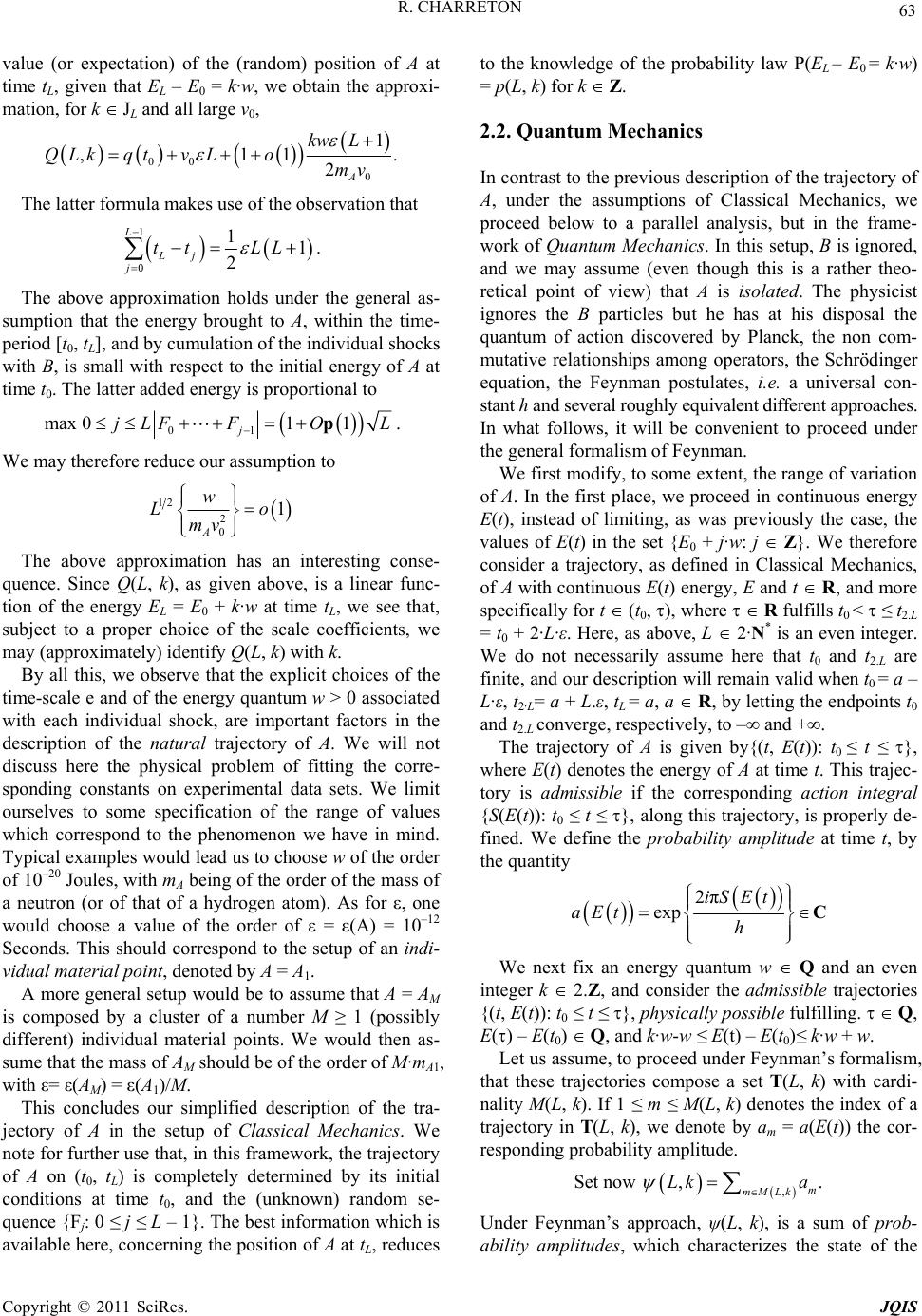 63 R. CHARRETON value (or expectation) of the (random) position of A at time tL, given that EL – E0 = k·w, we obtain the approxi- mation, for k JL and all large v0, 00 0 1 ,11 2A kw L QLkqtv Lomv . The latter formula makes use of the observation that 1 0 11 2 L Lj j tt LL . The above approximation holds under the general as- sumption that the energy brought to A, within the time- period [t0, tL], and by cumulation of the individual shocks with B, is small with respect to the initial energy of A at time t0. The latter added energy is proportional to 01 max 011 j jLFFOL p. We may therefore reduce our assumption to 12 2 0 1 A w Lo mv The above approximation has an interesting conse- quence. Since Q(L, k), as given above, is a linear func- tion of the energy EL = E0 + k·w at time tL, we see that, subject to a proper choice of the scale coefficients, we may (approximately) identify Q(L, k) with k. By all this, we observe that the explicit choices of the time-scale e and of the energy quantum w > 0 associated with each individual shock, are important factors in the description of the natural trajectory of A. We will not discuss here the physical problem of fitting the corre- sponding constants on experimental data sets. We limit ourselves to some specification of the range of values which correspond to the phenomenon we have in mind. Typical examples would lead us to choose w of the order of 10–20 Joules, with mA being of the order of the mass of a neutron (or of that of a hydrogen atom). As for ε, one would choose a value of the order of ε = ε(A) = 10–12 Seconds. This should correspond to the setup of an indi- vidual material point, denoted by A = A1. A more general setup would be to assume that A = AM is composed by a cluster of a number M ≥ 1 (possibly different) individual material points. We would then as- sume that the mass of AM should be of the order of M·mA1, with ε= ε(AM) = ε(A1)/M. This concludes our simplified description of the tra- jectory of A in the setup of Classical Mechanics. We note for further use that, in this framework, the trajectory of A on (t0, tL) is completely determined by its initial conditions at time t0, and the (unknown) random se- quence {Fj: 0 ≤ j ≤ L – 1}. The best information which is available here, concerning the position of A at tL, reduces to the knowledge of the probability law P(EL – E0 = k·w) = p(L, k) for k Z. 2.2. Quantum Mechanics In contrast to the previous description of the trajectory of A, under the assumptions of Classical Mechanics, we proceed below to a parallel analysis, but in the frame- work of Quantum Mechanics. In this setup, B is ignored, and we may assume (even though this is a rather theo- retical point of view) that A is isolated. The physicist ignores the B particles but he has at his disposal the quantum of action discovered by Planck, the non com- mutative relationships among operators, the Schrödinger equation, the Feynman postulates, i.e. a universal con- stant h and several roughly equivalent different approaches. In what follows, it will be convenient to proceed under the general formalism of Feynman. We first modify, to some extent, the range of variation of A. In the first place, we proceed in continuous energy E(t), instead of limiting, as was previously the case, the values of E(t) in the set {E0 + j·w: j Z}. We therefore consider a trajectory, as defined in Classical Mechanics, of A with continuous E(t) energy, E and t R, and more specifically for t (t0, ), where R fulfills t0 < ≤ t2.L = t0 + 2·L·ε. Here, as above, L 2·N* is an even integer. We do not necessarily assume here that t0 and t2.L are finite, and our description will remain valid when t0 = a – L·ε, t2·L= a + L.ε, tL = a, a R, by letting the endpoints t0 and t2.L converge, respectively, to –∞ and +∞. The trajectory of A is given by{(t, E(t)): t0 ≤ t ≤ }, where E(t) denotes the energy of A at time t. This trajec- tory is admissible if the corresponding action integral {S(E(t)): t0 ≤ t ≤ }, along this trajectory, is properly de- fined. We define the probability amplitude at time t, by the quantity 2π exp iS Et aEt h C We next fix an energy quantum w Q and an even integer k 2.Z, and consider the admissible trajectories {(t, E(t)): t0 ≤ t ≤ }, physically possible fulfilling. Q, E() – E(t0) Q, and k·w-w ≤ E(t) – E(t0)≤ k·w + w. Let us assume, to proceed under Feynman’s formalism, that these trajectories compose a set T(L, k) with cardi- nality M(L, k). If 1 ≤ m ≤ M(L, k) denotes the index of a trajectory in T(L, k), we denote by am = a(E(t)) the cor- responding probability amplitude. , Set now ,. m mMLk Lk a Under Feynman’s approach, ψ(L, k), is a sum of prob- ability amplitudes, which characterizes the state of the Copyright © 2011 SciRes. JQIS 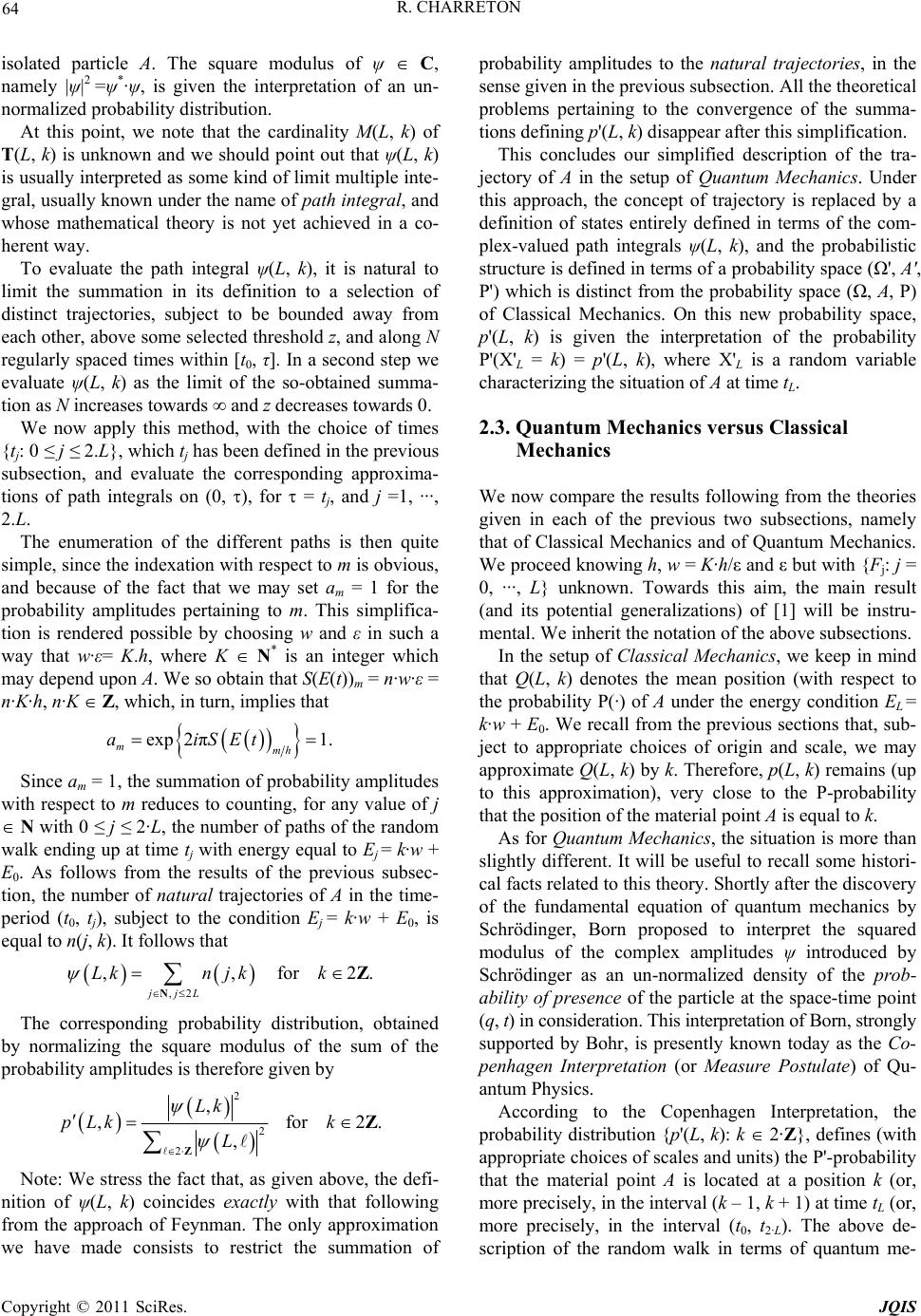 R. CHARRETON 64 isolated particle A. The square modulus of ψ C, namely |ψ|2 =ψ*·ψ, is given the interpretation of an un- normalized probability distribution. At this point, we note that the cardinality M(L, k) of T(L, k) is unknown and we should point out that ψ(L, k) is usually interpreted as some kind of limit multiple inte- gral, usually known under the name of path integral, and whose mathematical theory is not yet achieved in a co- herent way. To evaluate the path integral ψ(L, k), it is natural to limit the summation in its definition to a selection of distinct trajectories, subject to be bounded away from each other, above some selected threshold z, and along N regularly spaced times within [t0, τ]. In a second step we evaluate ψ(L, k) as the limit of the so-obtained summa- tion as N increases towards ∞ and z decreases towards 0. We now apply this method, with the choice of times {tj: 0 ≤ j ≤ 2.L}, which tj has been defined in the previous subsection, and evaluate the corresponding approxima- tions of path integrals on (0, ), for = tj, and j =1, ···, 2.L. The enumeration of the different paths is then quite simple, since the indexation with respect to m is obvious, and because of the fact that we may set am = 1 for the probability amplitudes pertaining to m. This simplifica- tion is rendered possible by choosing w and ε in such a way that w·ε= K.h, where K N* is an integer which may depend upon A. We so obtain that S(E(t))m = n·w·ε = n·K·h, n·K Z, which, in turn, implies that exp2 π1. mmh aiSEt Since am = 1, the summation of probability amplitudes with respect to m reduces to counting, for any value of j N with 0 ≤ j ≤ 2·L, the number of paths of the random walk ending up at time tj with energy equal to Ej = k·w + E0. As follows from the results of the previous subsec- tion, the number of natural trajectories of A in the time- period (t0, tj), subject to the condition Ej = k·w + E0, is equal to n(j, k). It follows that ,2 ,, for 2. jjL Lkn jkk NZ The corresponding probability distribution, obtained by normalizing the square modulus of the sum of the probability amplitudes is therefore given by 2 2 2 , , for 2. , Lk pLk k L Z Z Note: We stress the fact that, as given above, the defi- nition of ψ(L, k) coincides exactly with that following from the approach of Feynman. The only approximation we have made consists to restrict the summation of probability amplitudes to the natural trajectories, in the sense given in the previous subsection. All the theoretical problems pertaining to the convergence of the summa- tions defining p'(L, k) disappear after this simplification. This concludes our simplified description of the tra- jectory of A in the setup of Quantum Mechanics. Under this approach, the concept of trajectory is replaced by a definition of states entirely defined in terms of the com- plex-valued path integrals ψ(L, k), and the probabilistic structure is defined in terms of a probability space (Ω', A', P') which is distinct from the probability space (Ω, A, P) of Classical Mechanics. On this new probability space, p'(L, k) is given the interpretation of the probability P'(X'L = k) = p'(L, k), where X'L is a random variable characterizing the situation of A at time tL. 2.3. Quantum Mechanics versus Classical Mechanics We now compare the results following from the theories given in each of the previous two subsections, namely that of Classical Mechanics and of Quantum Mechanics. We proceed knowing h, w = K·h/ε and ε but with {Fj: j = 0, ···, L} unknown. Towards this aim, the main result (and its potential generalizations) of [1] will be instru- mental. We inherit the notation of the above subsections. In the setup of Classical Mechanics, we keep in mind that Q(L, k) denotes the mean position (with respect to the probability P(·) of A under the energy condition EL = k·w + E0. We recall from the previous sections that, sub- ject to appropriate choices of origin and scale, we may approximate Q(L, k) by k. Therefore, p(L, k) remains (up to this approximation), very close to the P-probability that the position of the material point A is equal to k. As for Quantum Mechanics, the situation is more than slightly different. It will be useful to recall some histori- cal facts related to this theory. Shortly after the discovery of the fundamental equation of quantum mechanics by Schrödinger, Born proposed to interpret the squared modulus of the complex amplitudes ψ introduced by Schrödinger as an un-normalized density of the prob- ability of presence of the particle at the space-time point (q, t) in consideration. This interpretation of Born, strongly supported by Bohr, is presently known today as the Co- penhagen Interpretation (or Measure Postulate) of Qu- antum Physics. According to the Copenhagen Interpretation, the probability distribution {p'(L, k): k 2·Z}, defines (with appropriate choices of scales and units) the P'-probability that the material point A is located at a position k (or, more precisely, in the interval (k – 1, k + 1) at time tL (or, more precisely, in the interval (t0, t2·L). The above de- scription of the random walk in terms of quantum me- Copyright © 2011 SciRes. JQIS 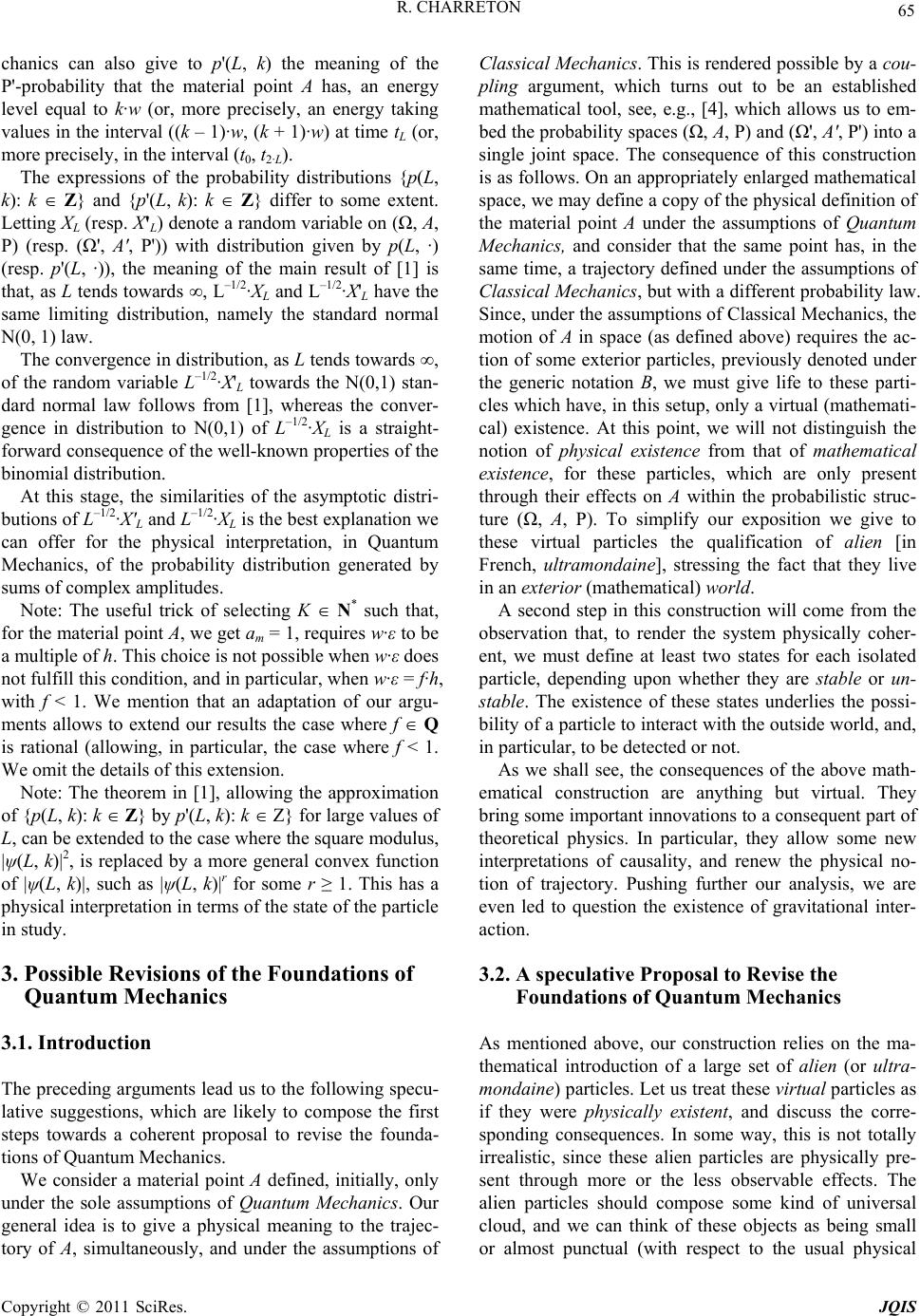 65 R. CHARRETON chanics can also give to p'(L, k) the meaning of the P'-probability that the material point A has, an energy level equal to k·w (or, more precisely, an energy taking values in the interval ((k – 1)·w, (k + 1)·w) at time tL (or, more precisely, in the interval (t0, t2·L). The expressions of the probability distributions {p(L, k): k Z} and {p'(L, k): k Z} differ to some extent. Letting XL (resp. X'L) denote a random variable on (Ω, A, P) (resp. (Ω', A', P')) with distribution given by p(L, ·) (resp. p'(L, ·)), the meaning of the main result of [1] is that, as L tends towards ∞, L–1/2·XL and L–1/2·X'L have the same limiting distribution, namely the standard normal N(0, 1) law. The convergence in distribution, as L tends towards ∞, of the random variable L–1/2·X'L towards the N(0,1) stan- dard normal law follows from [1], whereas the conver- gence in distribution to N(0,1) of L–1/2·XL is a straight- forward consequence of the well-known properties of the binomial distribution. At this stage, the similarities of the asymptotic distri- butions of L–1/2·X'L and L–1/2·XL is the best explanation we can offer for the physical interpretation, in Quantum Mechanics, of the probability distribution generated by sums of complex amplitudes. Note: The useful trick of selecting K N* such that, for the material point A, we get am = 1, requires w·ε to be a multiple of h. This choice is not possible when w·ε does not fulfill this condition, and in particular, when w·ε = f·h, with f < 1. We mention that an adaptation of our argu- ments allows to extend our results the case where f Q is rational (allowing, in particular, the case where f < 1. We omit the details of this extension. Note: The theorem in [1], allowing the approximation of {p(L, k): k Z} by p'(L, k): k Z} for large values of L, can be extended to the case where the square modulus, |ψ(L, k)|2, is replaced by a more general convex function of |ψ(L, k)|, such as |ψ(L, k)|r for some r ≥ 1. This has a physical interpretation in terms of the state of the particle in study. 3. Possible Revisions of the Foundations of Quantum Mechanics 3.1. Introduction The preceding arguments lead us to the following specu- lative suggestions, which are likely to compose the first steps towards a coherent proposal to revise the founda- tions of Quantum Mechanics. We consider a material point A defined, initially, only under the sole assumptions of Quantum Mechanics. Our general idea is to give a physical meaning to the trajec- tory of A, simultaneously, and under the assumptions of Classical Mechanics. This is rendered possible by a cou- pling argument, which turns out to be an established mathematical tool, see, e.g., [4], which allows us to em- bed the probability spaces (Ω, A, P) and (Ω', A', P') into a single joint space. The consequence of this construction is as follows. On an appropriately enlarged mathematical space, we may define a copy of the physical definition of the material point A under the assumptions of Quantum Mechanics, and consider that the same point has, in the same time, a trajectory defined under the assumptions of Classical Mechanics, but with a different probability law. Since, under the assumptions of Classical Mechanics, the motion of A in space (as defined above) requires the ac- tion of some exterior particles, previously denoted under the generic notation B, we must give life to these parti- cles which have, in this setup, only a virtual (mathemati- cal) existence. At this point, we will not distinguish the notion of physical existence from that of mathematical existence, for these particles, which are only present through their effects on A within the probabilistic struc- ture (Ω, A, P). To simplify our exposition we give to these virtual particles the qualification of a lien [in French, ultramondaine], stressing the fact that they live in an exterior (mathematical) world. A second step in this construction will come from the observation that, to render the system physically coher- ent, we must define at least two states for each isolated particle, depending upon whether they are stable or un- stable. The existence of these states underlies the possi- bility of a particle to interact with the outside world, and, in particular, to be detected or not. As we shall see, the consequences of the above math- ematical construction are anything but virtual. They bring some important innovations to a consequent part of theoretical physics. In particular, they allow some new interpretations of causality, and renew the physical no- tion of trajectory. Pushing further our analysis, we are even led to question the existence of gravitational inter- action. 3.2. A speculative Proposal to Revise the Foundations of Quantum Mechanics As mentioned above, our construction relies on the ma- thematical introduction of a large set of alien (or ultra- mondaine) particles. Let us treat these virtual particles as if they were physically existent, and discuss the corre- sponding consequences. In some way, this is not totally irrealistic, since these alien particles are physically pre- sent through more or the less observable effects. The alien particles should compose some kind of universal cloud, and we can think of these objects as being small or almost punctual (with respect to the usual physical Copyright © 2011 SciRes. JQIS 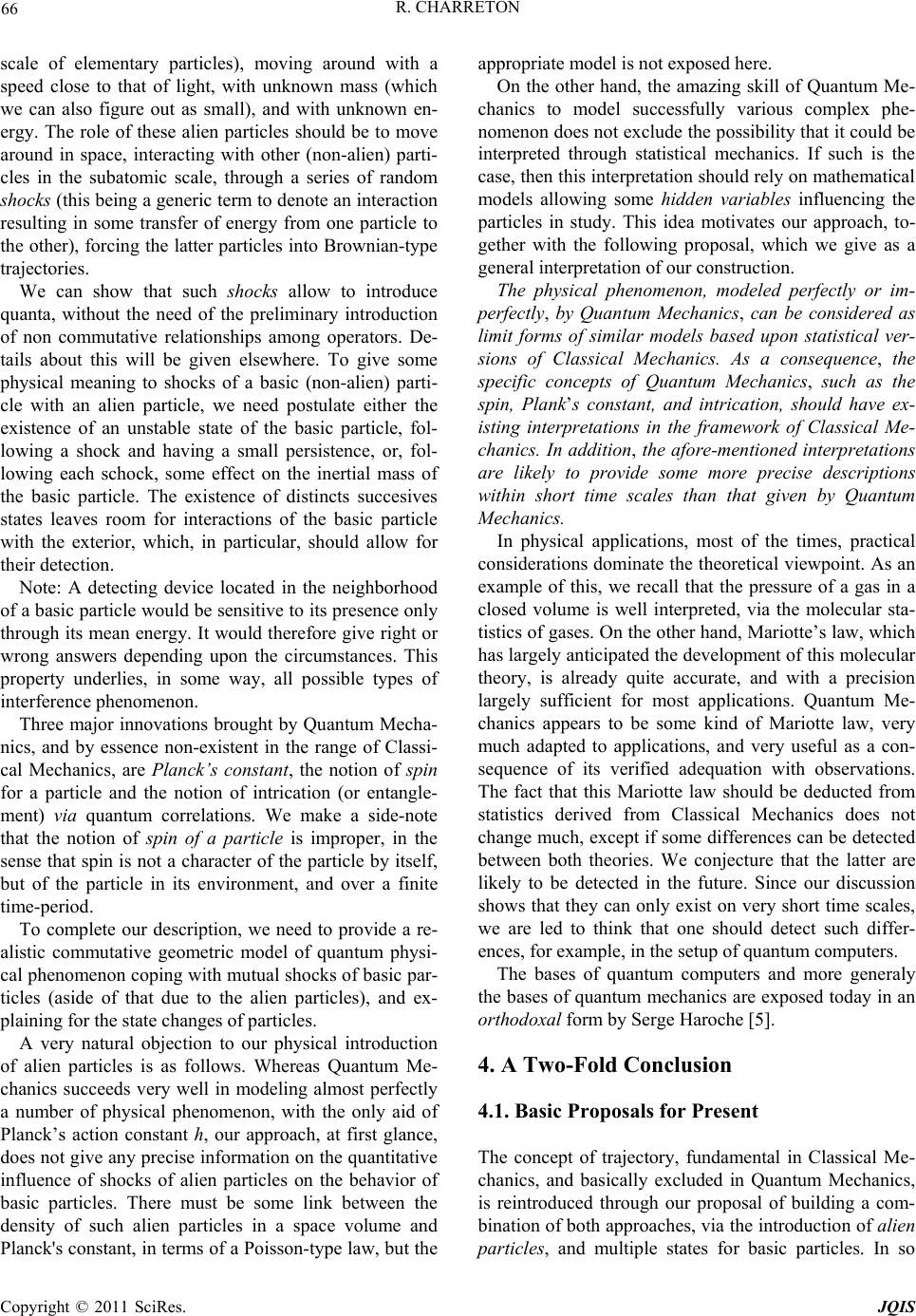 R. CHARRETON 66 scale of elementary particles), moving around with a speed close to that of light, with unknown mass (which we can also figure out as small), and with unknown en- ergy. The role of these alien particles should be to move around in space, interacting with other (non-alien) parti- cles in the subatomic scale, through a series of random shocks (this being a generic term to denote an interaction resulting in some transfer of energy from one particle to the other), forcing the latter particles into Brownian-type trajectories. We can show that such shocks allow to introduce quanta, without the need of the preliminary introduction of non commutative relationships among operators. De- tails about this will be given elsewhere. To give some physical meaning to shocks of a basic (non-alien) parti- cle with an alien particle, we need postulate either the existence of an unstable state of the basic particle, fol- lowing a shock and having a small persistence, or, fol- lowing each schock, some effect on the inertial mass of the basic particle. The existence of distincts succesives states leaves room for interactions of the basic particle with the exterior, which, in particular, should allow for their detection. Note: A detecting device located in the neighborhood of a basic particle would be sensitive to its presence only through its mean energy. It would therefore give right or wrong answers depending upon the circumstances. This property underlies, in some way, all possible types of interference phenomenon. Three major innovations brought by Quantum Mecha- nics, and by essence non-existent in the range of Classi- cal Mechanics, are Planck’s constant, the notion of sp in for a particle and the notion of intrication (or entangle- ment) via quantum correlations. We make a side-note that the notion of spin of a particle is improper, in the sense that spin is not a character of the particle by itself, but of the particle in its environment, and over a finite time-period. To complete our description, we need to provide a re- alistic commutative geometric model of quantum physi- cal phenomenon coping with mutual shocks of basic par- ticles (aside of that due to the alien particles), and ex- plaining for the state changes of particles. A very natural objection to our physical introduction of alien particles is as follows. Whereas Quantum Me- chanics succeeds very well in modeling almost perfectly a number of physical phenomenon, with the only aid of Planck’s action constant h, our approach, at first glance, does not give any precise information on the quantitative influence of shocks of alien particles on the behavior of basic particles. There must be some link between the density of such alien particles in a space volume and Planck's constant, in terms of a Poisson-type law, but the appropriate model is not exposed here. On the other hand, the amazing skill of Quantum Me- chanics to model successfully various complex phe- nomenon does not exclude the possibility that it could be interpreted through statistical mechanics. If such is the case, then this interpretation should rely on mathematical models allowing some hidden variables influencing the particles in study. This idea motivates our approach, to- gether with the following proposal, which we give as a general interpretation of our construction. The physical phenomenon, modeled perfectly or im- perfectly, by Quantum Mechanics, can be considered as limit forms of similar models based upon statistical ver- sions of Classical Mechanics. As a consequence, the specific concepts of Quantum Mechanics, such as the spin, Plank’s constant, and intrication, should have ex- isting interpretations in the framework of Classical Me- chanics. In addition, the afore-mentioned interpretations are likely to provide some more precise descriptions within short time scales than that given by Quantum Mechanics. In physical applications, most of the times, practical considerations dominate the theoretical viewpoint. As an example of this, we recall that the pressure of a gas in a closed volume is well interpreted, via the molecular sta- tistics of gases. On the other hand, Mariotte’s law, which has largely anticipated the development of this molecular theory, is already quite accurate, and with a precision largely sufficient for most applications. Quantum Me- chanics appears to be some kind of Mariotte law, very much adapted to applications, and very useful as a con- sequence of its verified adequation with observations. The fact that this Mariotte law should be deducted from statistics derived from Classical Mechanics does not change much, except if some differences can be detected between both theories. We conjecture that the latter are likely to be detected in the future. Since our discussion shows that they can only exist on very short time scales, we are led to think that one should detect such differ- ences, for example, in the setup of quantum computers. The bases of quantum computers and more generaly the bases of quantum mechanics are exposed today in an orthodoxal form by Serge Haroche [5]. 4. A Two-Fold Conclusion 4.1. Basic Proposals for Present The concept of trajectory, fundamental in Classical Me- chanics, and basically excluded in Quantum Mechanics, is reintroduced through our proposal of building a com- bination of both approaches, via the introduction of alien particles, and multiple states for basic particles. In so Copyright © 2011 SciRes. JQIS  67 R. CHARRETON doing, we reject non-commutative relations between op- erators, at the price of considering stable and unstable states for basic particles such as the photon, electron, neutron, or others. This last introduction appears as es- sential for the construction of a commutative geometry of particles, allowing in particular to restore the principle of causality. A commutative geometric model has the advantage of setting aside most of the usual “mysteries” of Quantum Physics. In particular: 1) The so-called tunnel effects corresponding to poten- tial level up-crossings receive a natural explanation for apparently isolated systems, if one considers the perva- sive influence of alien particles; 2) The natural disintegration of particles, such as that of the neutron, when it occurs, is interpreted not by some kind of natural magic, but rather, through the occurrence of appropriate shocks due to alien particles; 3) The undulatory character of a particle, as well as interferences of a particle with itself can be interpreted by changes of the particle state generated by a shock with an alien particle; 4) By this approach, the spin appears not to be a char- acter of the particle, but rather, a character of the trajec- tory of the particle during some appropriate time length. It follows that the conclusions which may be drawn from the experiments aiming to cope with Bell's inequality can be reinterpreted anew; 5) Since quantum space is not any more considered as empty, but rather occupied by the alien particles, the so- called ultraviolet catastrophe, can be better understood. Moreover, the possibility of building a link between the cosmological constant and the energy of empty space appears as more natural. We note that the discussion on what should be the proper interpretations of Quantum Mechanics has given rise to a number of controversies, opposing the greatest names of physics during the last 80 years. The debate is far from being closed at present, and we would like to mention the following comments of Franco Selleri [6], which support, to some extent, our point of view. One among the following three statements must be in error: 1) Nuclear objects exist independently of the human observers. 2) Any kind of interaction between two objects must tend to 0 when the mutual distance of these two objects tends to infinity. 3) Quantum Mechanics is exact. The P and P' probabilities, {p(L, k): k Z} and {p'(L, k): k Z}, pertaining to the above-given descriptions of the behavior of A, become asymptotically close to each other as L tends towards infinity, while remaining dis- tinct for each finite value of L. Here, L must be inter- preted as the number of shocks of alien particles with the particles composing A in a finite time-interval. In some sense, the Quantum Mechanics distribution {p'(L, k): k Z}appears as a limit law, so that the description of the phenomenon given by a causal process should provide a more accurate description of the behavior of A within a short finite time period. According to this interpretation, we consider that among the three candidates of Selleri, his proposal (3) should be the one to be selected as in error. By all this, our construction is likely to fulfill the ex- pectations of Dirac, who, as cited by Selleri (see, e.g., the concluding page of [6] expressed the following opinion. I think it likely that, in the forthcoming years, we will be able to build an improved version of Quantum Me- chanics, in which determinism will find a proper place. This, as a consequence, will justify the point of view of Einstein towards this matter. 4.2. Basic Program for Future Research The physical existence of a universal cloud of alien par- ticles would imply the possibility of bringing new an- swers to major issues related to gravitation. It is well- known that gravitation is subject to screen effects with- out apparent gravitational interaction. In such a setup, it appears as paradoxical with respect to the accepted physical theory that the delay of transmission of gravita- tional influence may become null or even negative. Only Poincaré had got so far as to speculate on such figures, in order to extend the principle of relativity to gravitation, see, e.g., [2,3]. Unfortunately, he could not find any physical evidence to support his assertions, and his pro- posal was not given more interest afterwards. We follow Poincaré's line of thought, by considering that the introduction of a universal cloud of alien parti- cles is prone to give the proper answers to the above physical questions concerning the notions of gravitation and inertial mass. We consider, namely, that by combin- ing the principles of lesser action and of entropy maxi- mization with the above-mentioned cloud of alien parti- cles, we may build two complementary forms of statisti- cal mechanics. The first one of these, which could be denoted as Quantum Statistical Mechanics, would differ to some extent from Classical Mechanics with respect to its de- velopments related to material points with small mass, such as that related to alien particles. On the other hand, it would come closer to Classical Mechanics for the de- scription of the behavior of material points with large mass (this being defined in the proper way). Quantum Mechanics in the sense given today should represent a Copyright © 2011 SciRes. JQIS 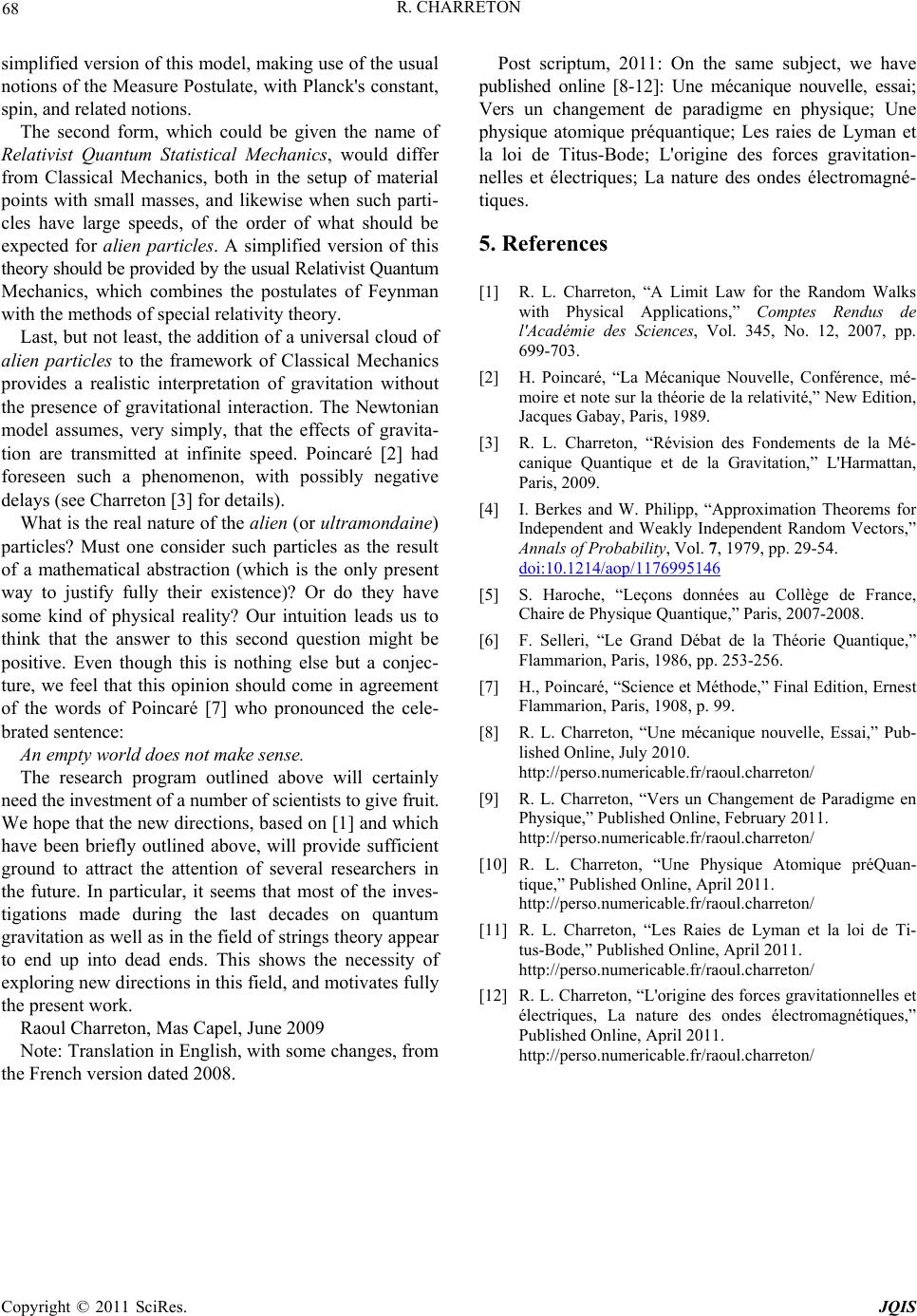 R. CHARRETON Copyright © 2011 SciRes. JQIS 68 simplified version of this model, making use of the usual notions of the Measure Postulate, with Planck's constant, spin, and related notions. The second form, which could be given the name of Relativist Quantum Statistical Mechanics, would differ from Classical Mechanics, both in the setup of material points with small masses, and likewise when such parti- cles have large speeds, of the order of what should be expected for alien particles. A simplified version of this theory should be provided by the usual Relativist Quantum Mechanics, which combines the postulates of Feynman with the methods of special relativity theory. Last, but not least, the addition of a universal cloud of alien particles to the framework of Classical Mechanics provides a realistic interpretation of gravitation without the presence of gravitational interaction. The Newtonian model assumes, very simply, that the effects of gravita- tion are transmitted at infinite speed. Poincaré [2] had foreseen such a phenomenon, with possibly negative delays (see Charreton [3] for details). What is the real nature of the alien (or ultramondaine) particles? Must one consider such particles as the result of a mathematical abstraction (which is the only present way to justify fully their existence)? Or do they have some kind of physical reality? Our intuition leads us to think that the answer to this second question might be positive. Even though this is nothing else but a conjec- ture, we feel that this opinion should come in agreement of the words of Poincaré [7] who pronounced the cele- brated sentence: An empty world does not make sense. The research program outlined above will certainly need the investment of a number of scientists to give fruit. We hope that the new directions, based on [1] and which have been briefly outlined above, will provide sufficient ground to attract the attention of several researchers in the future. In particular, it seems that most of the inves- tigations made during the last decades on quantum gravitation as well as in the field of strings theory appear to end up into dead ends. This shows the necessity of exploring new directions in this field, and motivates fully the present work. Raoul Charreton, Mas Capel, June 2009 Note: Translation in English, with some changes, from the French version dated 2008. Post scriptum, 2011: On the same subject, we have published online [8-12]: Une mécanique nouvelle, essai; Vers un changement de paradigme en physique; Une physique atomique préquantique; Les raies de Lyman et la loi de Titus-Bode; L'origine des forces gravitation- nelles et électriques; La nature des ondes électromagné- tiques. 5. References [1] R. L. Charreton, “A Limit Law for the Random Walks with Physical Applications,” Comptes Rendus de l'Académie des Sciences, Vol. 345, No. 12, 2007, pp. 699-703. [2] H. Poincaré, “La Mécanique Nouvelle, Conférence, mé- moire et note sur la théorie de la relativité,” New Edition, Jacques Gabay, Paris, 1989. [3] R. L. Charreton, “Révision des Fondements de la Mé- canique Quantique et de la Gravitation,” L'Harmattan, Paris, 2009. [4] I. Berkes and W. Philipp, “Approximation Theorems for Independent and Weakly Independent Random Vectors,” Annals of Probability, Vol. 7, 1979, pp. 29-54. doi:10.1214/aop/1176995146 [5] S. Haroche, “Leçons données au Collège de France, Chaire de Physique Quantique,” Paris, 2007-2008. [6] F. Selleri, “Le Grand Débat de la Théorie Quantique,” Flammarion, Paris, 1986, pp. 253-256. [7] H., Poincaré, “Science et Méthode,” Final Edition, Ernest Flammarion, Paris, 1908, p. 99. [8] R. L. Charreton, “Une mécanique nouvelle, Essai,” Pub- lished Online, July 2010. http://perso.numericable.fr/raoul.charreton/ [9] R. L. Charreton, “Vers un Changement de Paradigme en Physique,” Published Online, February 2011. http://perso.numericable.fr/raoul.charreton/ [10] R. L. Charreton, “Une Physique Atomique préQuan- tique,” Published Online, April 2011. http://perso.numericable.fr/raoul.charreton/ [11] R. L. Charreton, “Les Raies de Lyman et la loi de Ti- tus-Bode,” Published Online, April 2011. http://perso.numericable.fr/raoul.charreton/ [12] R. L. Charreton, “L'origine des forces gravitationnelles et électriques, La nature des ondes électromagnétiques,” Published Online, April 2011. http://perso.numericable.fr/raoul.charreton/
|